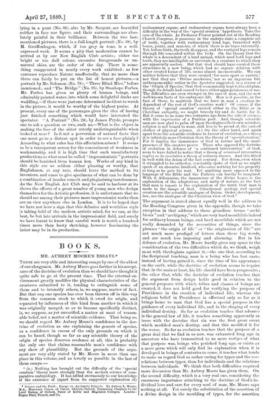ART.
THE NEW ENGLISH ART CLUB EXHIBITION OF PICTURES.
" CANDIDATES for election to membership of the New English Art Club will not be required to submit works, but their names, duly proposed and seconded must be sub- mitted before election." This is the leading sentence of the- code of rules, entitled " Constitution," which is to be found at the beginning of the catalogue of the New English Art Club's Exhibition; and it is not surprising to find that in the present exhibition, according to this rule, marvellous pictures are as common as blackberries on a hedgerow in autumn. Genius is rampant, originality is rife. The home of freedom is the- Dudley Gallery just now. There are such vagaries and pranks- played as never eyes were set on before. There is a woman's portrait (86) painted on " workhouse sheeting," and besides,. the poor creature has a vivid yellow face, and the texture on which she is portrayed forms a pattern diagonally over her damask cheek ; but this is a mere trifle, and we must not look through the face to the sheeting.
There is, without doubt, no little brilliance of tone to be got from the use of pastels, and, of course, one or two exhibitors, lovers of colour, have thoroughly appreciated this fact, some perhaps a trifle too strongly,—one, at any rate, to the very best purpose. "Three Blind Mice" (No. 6), by Elizabeth Armstrong, is an excellent picture, and its neighbours on the wall make it stand out and prove itself admirable in many ways. The group of children is well chosen, and the light thrown on the little faces, a curious if not a very novel effect in a picture, is well arrived at.
The variety of methods employed by the exhibitors at the Dudley Gallery just now is quite remarkable, specimens of nearly every known means for artists' work appearing in the room. Another noticeable fact is that the models chosen, as a rule, for portraits, have faces which it would seem are un- accustomed to the use of soap and water. Two or three seem uncommonly like half-castes, notwithstanding the fact that one is led to believe they are not other than ordinary Eng- lish men and women from their clothes and surroundings.. Blackness is a decidedly besetting sin here, and its compare, tive absence would benefit many works. An artist might at least choose a characteristic being for a model when he represents English life.
Several well-known names are on the list of exhibitors. From among them we select Mr. Sargent, to remark that he is, unfortunately, not seen at his best in the two pictures from his brash here. They are heavy in colour and otherwise unpleasing. In places, the greens are too strong, notably where the lady is walking by the river of vividly violet water (No. 69). The opposite bank seems to join on to her umbrella, and the reeds- and rushes are exceedingly stiff and careless. The two ladies lying in a punt (No. 66), also by Mr. Sargent, are beautiful neither in face nor figure, and their surroundings are abso- lutely painful in their brilliance. Between the two last- mentioned pictures, there is a full-length portrait (No. 68), by M. Greiffenhagen, which, if too grey in tone, is a well- expressed work. It seems a pity that moderation cannot be arrived at by our New English Club artists ; either too bright or too dull colour, excessive foregrounds or un- natural skies, are the order of the day. There is some- thing exaggerated in nearly every work exhibited : so few canvases reproduce Nature unaffectedly, that no more than three can fairly be put on the list of honest pictures,—a portrait by Mr. Solomon (No. 78); " Three Blind Mice," before mentioned ; and "The Bridge" (No. 95), by Stanhope Forbes. Mr. Forbes has given us plenty of human beings, and admirably painted water, into which some delightful ducks are waddling,—if there were just one determined incident to watch in the picture, it would be worthy of the highest praise. At present, every one of the personages gives the idea of having just finished something which would have interested the spectator. " A Portrait " (No. 24), by James Pryde, prompts one to ask a question or two, such as,—What is the object in making the face of the sitter utterly undistinguishable when looked at near ? Is it not a perversion of natural facts that one must go to a distant spot in order to see a face plainly ? According to what rules has this affectation arisen ? It seems to be a transparent screen for the concealment of weakness in workmanship, and it is high time that such unsatisfactory productions as what must be called " impressionistic " portraits should be banished from human ken. Works of any kind in this style are so seldom either pleasing or worthy, that Englishmen, at any rate, should leave the method to its inventors, and cease to give specimens of what can be done by a combination of insular conceit and plagiarising tastelessness. As the New English Art Club may be said to harbour at its shows the efforts of a great number of young men who design themselves for the Artistic profession, it is unfortunate that we should see among their pictures more impressionist works than are on view anywhere else in London. It is to be hoped that we have not here a sign that this delusive and worthless style is taking hold of the modern artistic mind, for we can, at the best, be but late arrivals in the impressionist field, and surely we have learnt to know that careful work is worth a hundred times more than hasty sketching, however fascinating the latter may be in its production.



































 Previous page
Previous page